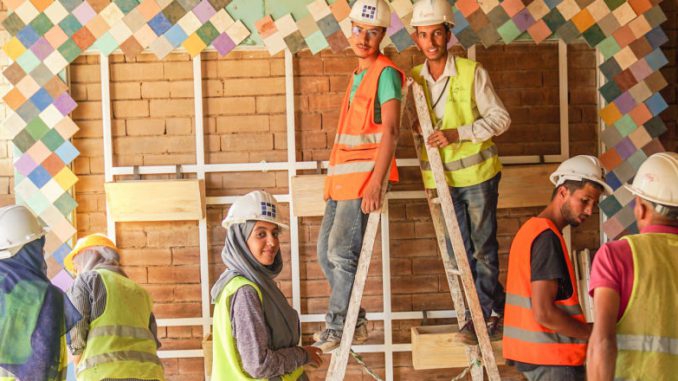
Throughout the 18 hours spent building a house under the scorching African sun, students at the Colorado Mining School were able to enjoy a special Moroccan tradition.
Twice a day, once in the late morning and once in the late afternoon, students were served hot tea with Moroccan mint and bread with apricot jam and olive oil.
Amundson is a part of a group of mining students who participated in Solar Decathlon AFRICA – an international college competition that challenges student teams to design, build and operate a full-scale solar home within five weeks.
Competing against 17 other teams of university students from around the world, the mining students and their Moroccan teammates won the Solar Decathlon AFRICA.
The Mining team was accepted to participate in the Solar Decathlon AFRICA in March 2018. By appointing the InterHouse, some 30 mining students worked on the planning and design of the house in which they would participate in the competition. They have partnered with about 45 students from two different universities in Morocco. Seven of the students from the Mines went to Morocco in August to start building the house. They had three weeks to build it before the two-week competition from September 13 to 27.
The evaluation covered 10 distinct aspects: evaluation of architecture, engineering and construction of the house, market attractiveness, social awareness, household appliances, quality of life, sustainability, health and comfort, energy balance and innovation.
The house that the students of Mines and their Moroccan partners built is U-shaped with a courtyard and carport totaling about 1,000 square feet. It has two bedrooms, a bathroom, a kitchen, a laundry room and a living room.
The concept is to combine traditional Moroccan architecture and interior design with modern technology,” said Katie Schneider, a graduate student at Mines, who was a project manager for InterHouse.
Ms. Schneider was unable to travel to Morocco, but she helped her teammates in Africa as a contact point on campus and kept the broader mining community informed of the progress of the competition.
The Interhouse is self-sufficient energy and uses an intelligent system, which means it has sensors that measure temperature, humidity, indoor air quality and lighting. It is powered entirely by solar energy – using batteries from a Nissan Leaf electric car to store its energy.
The house’s custom battery unit and HVAC system were shipped to Morocco. Other building materials, such as compressed and stabilized earth bricks, which are similar to adobe, used to build the house have been obtained in Morocco.
Now that the competition is over, the site of the 18 houses built for the Solar Decathlon AFRICA will probably be transformed into a smart green village, Ohno said. They may become private residences, but are more likely to be used as model homes and/or for research purposes.
Lucy Davis, a civil engineering student at Mines, became involved in the project from the beginning with the small house in Mines when she was in her first year. She was the co-head of the project and the main structural designer of the InterHouse and was one of seven female mining students who traveled to Morocco for the competition.
Ms. Davis said she learned a lot about her own leadership and problem-solving skills, as well as the new friendships she had made throughout her life while working on the project.
All the work on the small house and the InterHouse was entirely volunteer and extracurricular – no school credits were obtained for participation in either project.

Be the first to comment